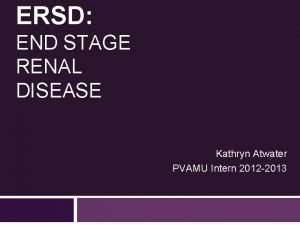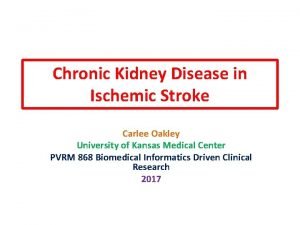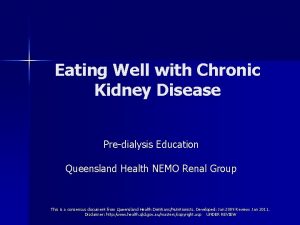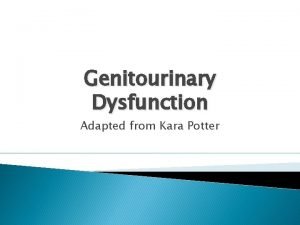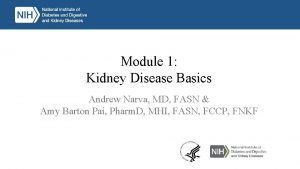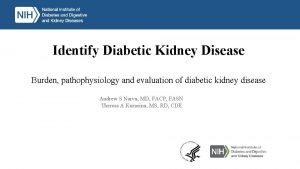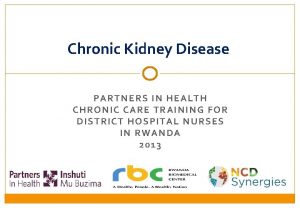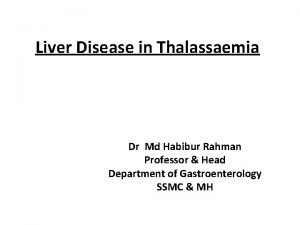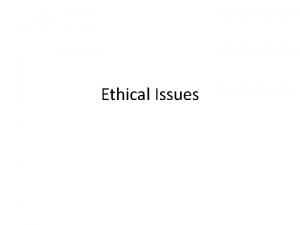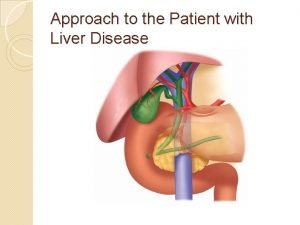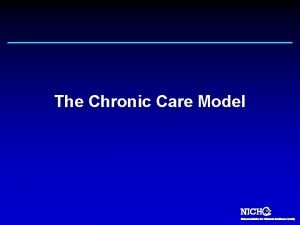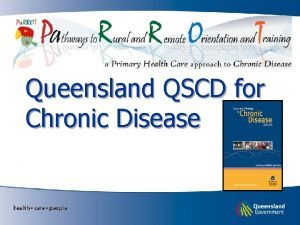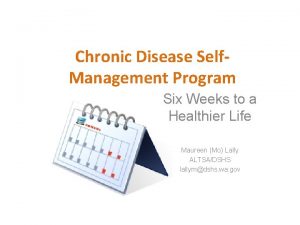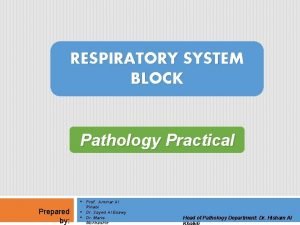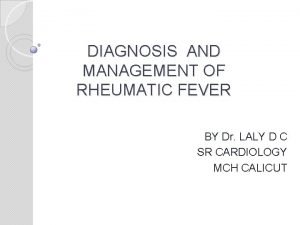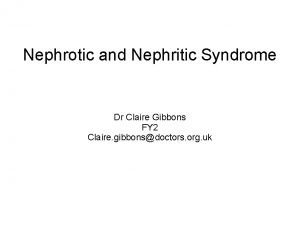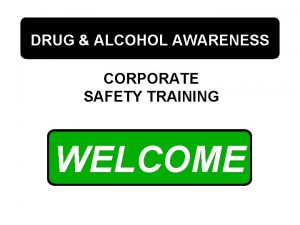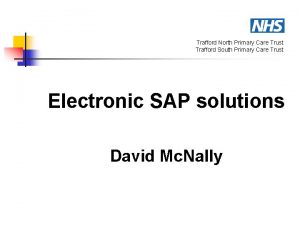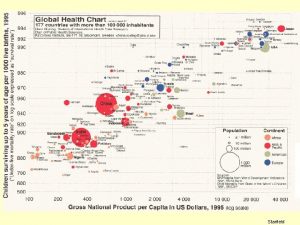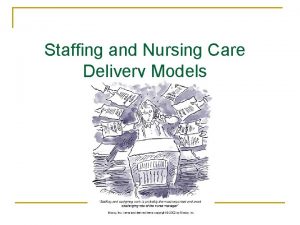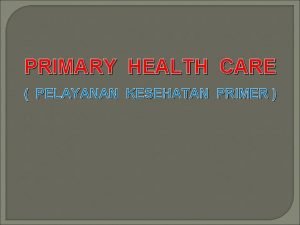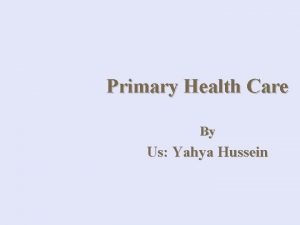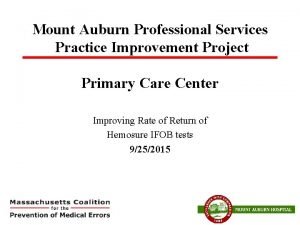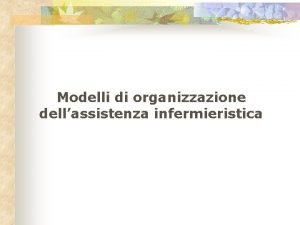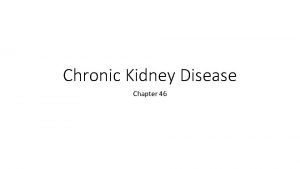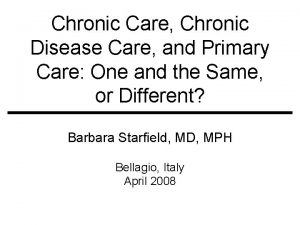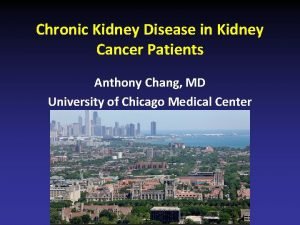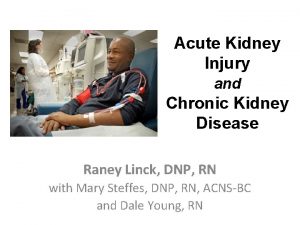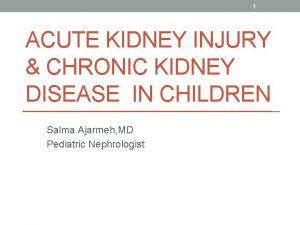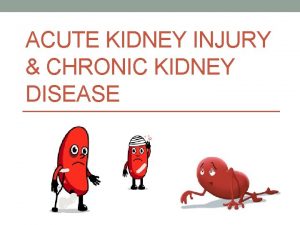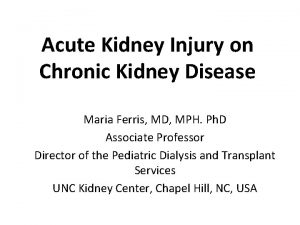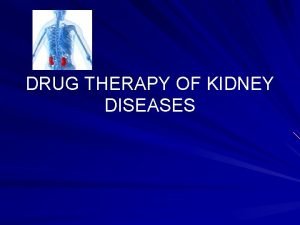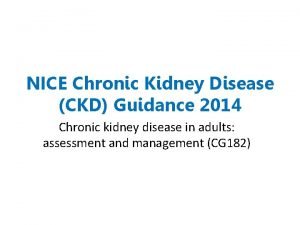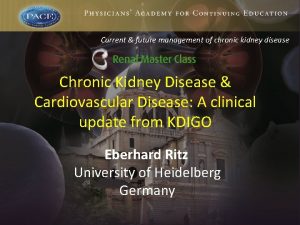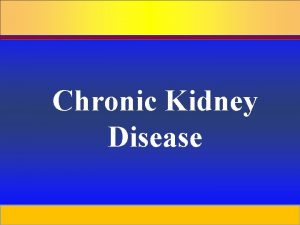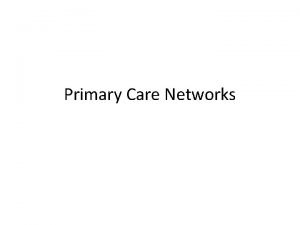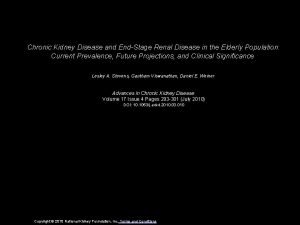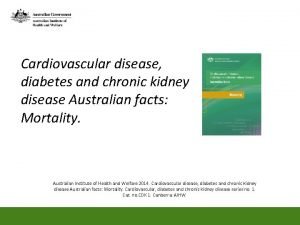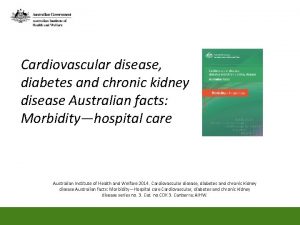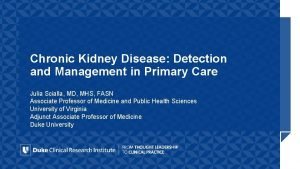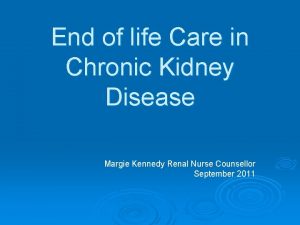Drug Safety in Chronic Kidney Disease Primary Care
























































- Slides: 56

Drug Safety in Chronic Kidney Disease Primary Care Clinician Conference 4/26/14 Michael J Choi, MD Johns Hopkins University School of Medicine mchoi 3@jhmi. edu Disclosures: National Kidney Foundation Kidney Disease Outcomes Quality Initiative Vice Chair of Education

Learning Objectives • Recognize risk factors for drug-related adverse events in patients with CKD • Identify ways how drugs could lead to adverse events in patients with CKD • Recognize commonly used drugs that require dose adjustment or use with caution in patients with CKD

DRUG-RELATED ADVERSE SAFETY EVENTS IN CKD

How often? And Who’s at risk? • Occurs in ~50% of patients with estimated GFR (e. GFR) <60 ml/min • Risk factors • • • Non-white Older age ACEi/ ARB use Diabetes More advanced CKD Ginsberg JS, et al. J Am Soc Nephrol 2014.

Rate of adverse drug events in ambulatory patients with CKD N=267 PATIENT REPORTED Rate (per 100 patients)* Hypoglycemia 57. 6 Falling/ severe dizziness 23. 1 Nausea, vomiting ± diarrhea 21. 1 Hyperkalemia 18. 1 Confusion 16. 9 DETECTED AT STUDY VISIT Hypoglycemia 8. 3 Hyperkalemia 8. 3 Bradycardia 6. 4 *Adjusted for sociodemographics, comorbid conditions, GFR, and number of medications Adapted from Ginsberg JS, et al. J Am Soc Nephrol 2014.

CKD and medication safety Fink et al. KI 2009; 76: 1123– 1125

CKD progression: biology versus “iatrogenesis”? Fink, et al, AJKD, 2009

CKD progression: biology versus “iatrogenesis”? Fink, et al, AJKD, 2009

Modes of Drug-Related Adverse Events in CKD • Direct kidney injury • Dosing error • Drug-drug interaction

Drug Elimination in CKD • Adjustments usually needed when >25 -30% of active drug/metabolite eliminated renally: – – – Azithromycin 5 -12% Moxifloxacin 15 -21% Pioglitazone (Actos) 15 -30% Ciprofloxacin 30 -57% Amoxicillin 50 -70% Digoxin 57 -80% • 10

DRUGS TO AVOID IN CKD PATIENTS

Case Presentation 74 yo W woman with right hip pain. 2 wks earlier Scr was 1. 3 mg/dl, e. GFR of 43 ml/min/1. 73 m 2 Meds: Tramadol 50 mg qd, HCTZ 25 mg qd, irbesartan 300 mg qd. Added Gabapentin 300 mg qd. Pain continued and she took OTC ibuprofen 200 mg qid. Poor po intake. Fell and was admitted. BP 110/60 mm. Hg, HR 100. Scr ↑ 1. 6 mg/dl Given IVF and discontinued HCTZ. Which other medication(s) would you stop for the AKI? A. Irbesratan B. Ibuprofen C. Both irbesartan and ibuprofen D. Tramadol

Afferent Glomerulus Efferent PG AII ↑PG ↑AII Normal ↓volume NSAIDS ↓PG ↓volume with ACEi + NSAID ACEi/ARB ↓AII

NSAIDs • Injure kidneys directly – Induce acute kidney injury (AKI) from “pre-renal” or ATN – Interstitial nephritis – Nephrotic syndrome • Decrease kidney potassium excretion → hyperkalemia • Decrease sodium excretion → HTN, edema

NSAIDs • Avoid in patients with: – CKD – Conditions that could lead to “prerenal physiology” or dehydration • • CHF Cirrhosis Renal artery stenosis RAAS-blockade

Case presentation 70 yo W woman with HTN, DM, CKD. 3 mo ago - Scr 1. 2 mg/dl, e. GFR 42 ml/min/1. 73 m 2, CO 2 23 m. Eq/l, urine albumin to creatinine ratio (ACR) 320 mg/g. She is fatigued. Severely constipated with ↓oral intake, but now with loose stools after OTC laxatives, but not dizzy. Meds: Losartan/HCTZ, metformin. BP 136/70 mm. Hg (~ baseline 140/80 ). Scr 4. 0 mg/dl, CO 2 21 m. Eq/l. You call her for to go to the ER and ask about OTC NSAIDs. What do you think happened? A. Progression of CKD B. Too much RAAS blockade with too low target blood pressure C. Metformin induced AKI D. Phosphate containing laxatives

Oral Sodium Phosphate – Phosphate Content Phosphate content (mmol) Osmoprep (32 tablets) Visicol (40 tablets) Fleets enema (133 ml) 345. 6 mmol 432 mmol 90 mmol Mean phosphate 48 / 33 mmol intake USA (men/women) OSMOPREP Package Insert, 2007

Oral Sodium Phosphate Preparations • Hyperphosphatemia + volume depletion • Acute Phosphate Nephropathy – Ca-phosphate deposits in tubules & interstitium – Leads to AKI/ CKD within days to months Desmeules S, et al. N Engl J Med. 2003

Sodium Phosphate Bowel Preparations • 1/14/14 - FDA Blackbox warning for OTC oral sodium phosphate tablets: do not to take more than one dose/24 hours • Risk Factors – Older age, – Impaired kidney function – Pre-renal state/ physiology – Decreased GI motility – ACEi, ARB or NSAID use

Iodinated Contrast • Leads to AKI • Risk factors – CKD (esp. e. GFR <30 ml/min/1. 73 m 2) – Diabetes, CHF, gout – Dehydration – Concurrent use of NSAIDs or RAAS-antagonists – High osmolality agents, large or repeated doses – Intra-arterial injection

Iodinated Contrast • Minimize risk of AKI – Use low or iso-osmolar agents at lowest doses possible – Consider d/c NSAIDS, diuretics or RAAS-antagonists prior and shortly after procedure – Optimize volume status – Check Scr 48 -96 hrs post-procedure – Avoid repeated contrast load within days • Prophylactic hemofiltration/hemodialysis of no benefit KDIGO Guidelines on CKD Diagnosis and Management. Kidney Int. 2013.

Does fluid type matter in preventing contrast nephropathy? Group A: NS 1 ml/kg/h starting @ 8 h pre- and continued ≥ 12 h postprocedure Group B: Na. HCO 3 (166 m. Eq/L) 3 ml/kg/h 1 h pre- and 1 ml/kg/h for 6 h post-procedure Group C: Na. HCO 3 3 ml/kg bolus 20 mins pre + 1, 500 mg tab/10 kg + 100 -200 ml mineral water orally and 500 ml of mineral water postprocedure Klima T, et al. Euro Heart J, 2012.

Gadolinium • Linked to nephrogenic systemic fibrosis (NSF) – Rare, but painful debilitating fibrosing disease – Primarily in extremities but may involve lung and heart • Increased risk w/ decreased kidney function (AKI, CKD, posttransplant) • Avoid gadolinium in patients w/ e. GFR <30 ml/min Grobner T and Prischl FC. Kidney Int 2007 • Contraindication in PD • HD patients require immediate HD post-exposure x 3 d • No effective treatment available Swaminathan S and Shah S. J Am Soc Nephrol. 2007.

CKD Gad concentration hours Gad Clearance – ↓↓ in CKD and Peritoneal Dialysis Time (hrs) after Gad admin Magnevist 0. 1 mmol/kg x 1 (N=24) Cr. Cl 7. 2 -70 ml/min 92. 1% recovered in urine Magnevist 0. 1 mmol/kg CAPD 2 L exchanges 4 x/day ½ life 9 hrs Swan, S Invest Radiol 34: 443, 1999; Swan, S J Mag Res Imag 9: 317, 1999 Dorsam, J. NDT 10: 1228, 1995

DRUGS THAT REQUIRE CAUTION IN CKD PATIENTS

Antihypertensives: RAAS antagonists • Expect rise in SCr ≤ 30% • Can lead to AKI, hyperkalemia • Risk management – Avoid in patients with renal artery stenosis – Assess e. GFR and serum K+ 1 wk after initiation or ↑dose – Prior to contrast, major surgery, procedures /conditions that predispose to dehydration - consider temporarily d/c – D/C or reduce if SCr increase > 30% or serum K+ > 5. 5 m. Eq/L KDIGO Guidelines on CKD Diagnosis and Management. Kidney Int. 2013.

Antihypertensives: RAAS antagonists • In severe CKD, consider* but do not routinely stop RAAS blockers as there may be continued nephroprotection. . Ahmed AK et al. The impact of stopping inhibitors of the renin angiotensin system in patients with advanced chronic kidney disease. Nephrol Dial Transplant 2010; 25: 3977– 3982.

Case Presentation 74 yo woman with right hip pain. 2 wks earlier Scr 1. 3 mg/dl. Fell and was admitted. Scr 1. 6 mg/dl. Given IVF and discontinued HCTZ, ibuprofen and irbesartan. Urinalysis shows ATN. More hip pain. Tramadol 50 mg qd. ↑Gapabentin 300 tid. 5 days after admission: Na 132 m. Eq/l, BUN 50 mg/dl, Scr 2 mg/dl. She has ↑drowsiness + asterixis. What is contributing most to her sxs and signs and what should we do? A. Dialysis for uremia B. D/c tramadol, give naloxone C. D/c gabapentin D. Treat hyponatremia

• Mayo clinic – 33/594 with GFR < 90 ml/min developed side effects • 7/9 ESRD patients had side effects


Gabapentin Cr. Cl (m. L/min) > 60 31 – 60 15 – 30 < 15 Hemodialysis Total daily dose (mg) Dosage regimen 1, 200 600 400 mg TID 300 mg BID 300 mg QD 150 300 mg QOD 200 – 300 mg post-HD — Loading dose: 300 – 400 mg Maintenance dose: 200 – 300 mg after each 4 -h HD session • 31

Case Presentation 74 yo W woman Scr of 1. 9 mg/dl, e. GFR 34 ml/min/1. 73 m 2 has dysuria, urgency. Urinalysis reveals 3+ leukocyte esterase. Which antibiotic will be the best for efficacy, but will also need to be dose adjusted for CKD? A. Cephalexin B. Ciprofloxacin C. Nitrofurantoin D. All of the above

Treatment Considerations in CKD Patients with UTI Ampicillin* • Achieve good urine concentration Cephalosporins* • Generally low urine concentrations • Exceptions: cefazolin and ceftriaxone, but not FDA approved for UTI treatment Carbepenems • <50% of active drug present in urine • Unknown efficacy for UTI in CKD patients Quinolones* • Ciprofloxacin and levofloxacin achieve good urine concentrations Nitrofurantoin • Low renal excretion, avoid if e. GFR <50 ml/min Trimethoprim* • Achieve good urine concentration Aminoglycosides* • Achieve high urine concentrations • Nephrotoxic *Requires dose adjustment in CKD Adapted from Gilbert DN, J Am Soc Nephrol. 2006

Antimicrobials with CKD • Most require renal dose adjustments – Common exceptions: Ceftriaxone, moxifloxacin, macrolides, doxycycline, clindamycin, linezolid • Careful monitoring of drug levels needed for: – Vancomycin. Aminoglycosides • Trimethoprim/ sulfamethoxazole – May ↑SCr slightly due to ↓renal tubular creatinine excretion– no change in GFR. – Distinguish from AKI due to drug allergic interstitial nephritis – Hyperkalemia • Imipenem/ cilastatin – High seizure risk in CKD patients, use carbepenem in CKD KDIGO Guidelines on CKD Diagnosis and Management. Kidney Int. 2013. Munar MY and Singh H. Am Fam Physician, 2007.

Case Presentation 45 yo AA man with diabetes and HTN. He is on metformin with a Hgb. A 1 C 6. 9, and has lost 15 lbs. Scr 1. 5 mg/d last year, ↑ 1. 6 mg/dl with e. GFR of 59 ml/min/1. 73 m 2, ACR 200 mg/g, serum K+ 5 m. Eq/l. He is on losartan 100 mg/d with BP 130/80 mm. Hg. He has no complaints. What should we do for his diabetes? A. D/c metformin, add glyburide B. D/c metformin, add glipizide C. Add lisinopril D. No medication changes

Metformin • Ideal agent – Does not raise insulin levels – No hypoglycemia • Lactic acidosis – 1/20 th of phenformin – ~3 cases per 100, 00 pt-yr • Original cutpoints based on metabolizing 3 g in 24– 48 h – Females, SCr 1. 4 mg/d. L – Males, SCr 1. 5 mg/d. L • 36 Lipska KJ, et al. Diabetes care. 2011; 34: 931.

Proposed Metformin Use in CKD • e. GFR 45 to 60 m. L/min/1. 73 m 2 – Continue metformin use and ↑ monitoring of e. GFR to every 3 - 6 months • e. GFR 30 to 45 m. L/min/1. 73 m 2 – Use metformin with caution with lower dose (50% maximal) • e. GFR < 30 m. L/min/1. 73 m 2 – Stop metformin Lipska KJ, et al. Use of Meformin in the Setting of Mild-to-Moderate Renal Insufficiency. Diabetes Care 2011; 34: 1431 -37.

Proposed Metformin Use in CKD • Avoid or hold if Acute Kidney Injury or high risk AKI – Iodinated contrast exposure • Monitor Serum Bicarbonate in addition to e. GFR – Stop metformin for any new acidosis Lipska KJ, et al. Use of Meformin in the Setting of Mild-to-Moderate Renal Insufficiency. Diabetes Care 2011; 34: 1431 -37.

Hypoglycemics • Sulfonylureas – Dose adjustment needed for renally excreted drugs: chlorpropramide, glyburide – Avoid above two if e. GFR < 50 ml/min • Insulin – Partially renally excreted and dose adjustment may be needed for e. GFR <30 ml/min KDIGO Guidelines on CKD Diagnosis and Management. Kidney Int. 2013. Munar MY and Singh H. Am Fam Physician, 2007.

Antidiabetic Drugs & CKD Generic Name Sulfonylureas glyburide glipizide Hypogl ↓A 1 c ↑Wt ycemia 1. 0– Yes 1. 5 Initial Dose Max Dose CKD 2. 5– 5 mg/d 10 mg BID avoid 5 mg/d or 20 mg BID or use this one XL 5 mg/d XL 20 mg/d http: //www. corbisimages. com/stock-photo/rights-managed/SF 9381/stephen-hales • 40 measuring-horses-blood-pressure

Case Presentation 64 yo AA woman with weakness. PMH of HTN, hypercholesterolemia CKD with Scr of 1. 4 mg/dl, e. GFR of 45 ml/min/1. 73 m 2 , ACR 30 mg/g, Meds: Diltiazem, Simvastatin, ASA EGD with H. pylori. Rx: Clarithromycin, Metronidazole, Bismuth + PPI 7 d after starting regimen c/o severe weakness Exam: 110/70 mm. Hg, tachycardia, ↓ lower extremity strength. Na 138 K 6. 4 Cl 98 HCO 3 14 BUN 89 Cr 5. 8. CK 80, 000 IU/L Why did this happen?

Lipid-lowering drugs • Statins – No renal dose adjustment needed for atorvastatin – Dose adjustments needed when e. GFR <30 ml/min for fluvastatin, lovastatin, pravastatin, rosuvastatin and simvistatin • Fibrates – Associated with AKI esp. in CKD patients – May transiently raise SCr by increased creatinine production rather than decreased GFR KDIGO Guidelines on CKD Diagnosis and Management. Kidney Int. 2013. Munar MY and Singh H. Am Fam Physician, 2007.

AWARENESS OF DRUG INTERACTIONS IN PATIENTS

Rhabdomyolysis with Statins: Cytochrome P 450 3 A 4 interactions Lova >/= Simva > Atorva – not Rosuva or Prava • Azoles (ketoconazole the worst) • Diltazem and Verapamil • Clarithro and Erythro >>> Azithro • Ritonavir in HIV patients • Cyclosporine and FK 506 (Tacrolimus)

CYP 450 3 A 4 Interactions Diltiazem with lovastatin and pravastatin Pravastatin LOG SCALE Lovastatin Azie NE, et al. Clin Pharmacol Ther 1998; 64: 369

Case Presentation 74 yo old AA woman with e. GFR of 20 ml/min/1. 73 m 2 DEXA scan shows osteopenia/osteoporosis. 25 OH vitamin D level with supplementation 65, intact PTH 25, calcium 10. 8 mg/dl, phosphate is 5. 1 mg/dl. What would you do for the DEXA scan findings? A. Add bisphonate B. Increase vitamin D C. Repeat DEXA next year as repeat testing ↑accuracy of test D. None of the above.

Bisphonates • Bisphonates for e. GFR > 30 m. L/min/ 1. 73 m 2 with normal Ca, phos, intact PTH with DEXA scans showing osteoporosis. • Efficacy? – BMD weakly related to fracture risk with stages 4 and 5 CKD* • Patients with Chronic Kidney Disease -Mineral Bone Disorder have a spectrum of bone diseases – secondary hyperparathyroidism with ↑bone turnover BUT adynamic bone disease with ↓bone turnover as well. Ott SM. Nat Rev Nephology 2013; 9: 681 -692.

Bisphonates • Safe? – Long term treatment with bisphonates may cause or exacerbate adynamic bone disease. • Refer to a bone specialist with osteoporosis with e. GFR< 30 min per 1. 73 m 2 ml/min • Rare kidney toxicity – IV zolendronic acid associated with AKI due to ATN. – IV pamidronate, zolendronic acid, oral alendronate reported with collapsing FSGS.

AVOIDING DRUG TOXICITY IN CKD PATIENTS

Minimizing Risk of Adverse Drug Events • Minimize pill burden as possible – 10 – 12 MEDICATIONS PER CKD PATIENT; 17 FOR TRANSPLANTED INDIVIDUALS • Review medications carefully for – Dosing – Potential interactions • Educate patient on: – OTC meds to avoid (mainly NSAIDs) – Signs/symptoms of potential drug adverse effects St. Peter WL, Adv Chronic Kidney Dis. 2010; 17: 413 -9 Yee J. Adv Chronic Kidney Dis. 2010; 17: 379 -380

Dosing Adjustments • Don’t rely on SCr alone – calculate e. GFR or Cr clearance – SCr misleading in: extremes of body weight, poor nutrition • Cannot rely on e. GFR in AKI – If SCr rapidly rising, assume e. GFR <10 ml/min • When in doubt, look up dosing adjustment/ potential interactions or call pharmacy

Key Points • CKD patients at high risk for drug-related adverse events • Several classes of drugs renally eliminated • Consider kidney function and current e. GFR (not just SCr) when prescribing meds • Minimize pill burden as much as possible • Remind CKD patients to avoid NSAIDs


Common drugs that require dose adjustment in CKD • Metoclopramide – Overdose manifests as CNS symptoms/ extrapyramidal movement disorders – 50% of normal dose if e. GFR <40 ml/min • Digoxin – ~70% of digoxin is renally eliminated – 30 -50% dose reduction for loading – Maintenance dose reduction based on kidney function & ideal body wt. Bauman JL, et al. Arch Intern Med, 2006.

Antidiabetic Drugs & CKD Generic Name A 1 c Hypogl ↓ ycemia 1. 0– Meglitinides Yes 1. 5 re paglinide na teglinide Wt ↑ Yes Initial Dose 0. 5 mg TID 120 mg TID Max Dose $ / mo CKD Can be used in the presence of renal failure as the pharmacokinetics are unaffected 4 mg TID $0 180 mg TID $0 http: //www. corbisimages. com/stock-photo/rights-managed/SF 9381/stephen-hales • 55 measuring-horses-blood-pressure

Antidiabetic Drugs & CKD Generic Name alphaglucosidase inhibitors ac arbose mi glitol A 1 c Hypogl ↓ ycemia Wt ↑ Initial Dose Max Dose 0. 5– No 1. 0 No 25 mg TID 100 mg TID $40 25 mg TID 100 mg TID $60 $ / mo CKD Contraindicated in renal failure http: //www. corbisimages. com/stock-photo/rights-managed/SF 9381/stephen-hales • 56 measuring-horses-blood-pressure
 Nephrology near atwater
Nephrology near atwater Chronic kidney disease near oakley
Chronic kidney disease near oakley Primary secondary tertiary care nursing
Primary secondary tertiary care nursing Nemo kidney disease
Nemo kidney disease Sighns of kidney problems
Sighns of kidney problems Resonium por
Resonium por Albumin kidney disease
Albumin kidney disease Albumin kidney disease
Albumin kidney disease Symptomatic polycystic kidney disease
Symptomatic polycystic kidney disease Chronic granulomatous disease
Chronic granulomatous disease Stigmata of chronic liver disease
Stigmata of chronic liver disease Jewish chronic disease study
Jewish chronic disease study Dcld vs cld
Dcld vs cld Peripheral stigmata of cld
Peripheral stigmata of cld Stigmata of chronic liver disease
Stigmata of chronic liver disease Kate lorig chronic disease self-management
Kate lorig chronic disease self-management Developedbyed
Developedbyed Chronic disease
Chronic disease Stage 3 liver disease
Stage 3 liver disease Chronic disease
Chronic disease Emphysème
Emphysème Vijaya's echo criteria
Vijaya's echo criteria Nigel gibbons
Nigel gibbons Qbs safety care
Qbs safety care Example of substitution with exhausted drug is
Example of substitution with exhausted drug is Chronic unease in the workplace
Chronic unease in the workplace Chronic care model definition
Chronic care model definition Chronic care solutions
Chronic care solutions Flinders model
Flinders model Chronic care
Chronic care Hepatitis a incubation period
Hepatitis a incubation period Improving chronic illness care model
Improving chronic illness care model Wagner chronic care model 1998
Wagner chronic care model 1998 Chronic care solutions
Chronic care solutions Communicable disease and non communicable disease
Communicable disease and non communicable disease Drug and alcohol safety training
Drug and alcohol safety training Yellow magenta and cyan are the ___
Yellow magenta and cyan are the ___ Safety depth formula in ecdis
Safety depth formula in ecdis Personal safety vs process safety
Personal safety vs process safety Ind safety report
Ind safety report Basic safety construction site safety orientation
Basic safety construction site safety orientation Basic safety construction site safety orientation
Basic safety construction site safety orientation Trafford primary care trust
Trafford primary care trust Uccs veterans health and trauma clinic
Uccs veterans health and trauma clinic Australian primary health care research institute
Australian primary health care research institute Starfield primary care
Starfield primary care Functional nursing care delivery model
Functional nursing care delivery model Dc primary care association
Dc primary care association Makalah primary health care
Makalah primary health care Principles of primary health care
Principles of primary health care Site:slidetodoc.com
Site:slidetodoc.com Defination of phc
Defination of phc Provision of essential drugs
Provision of essential drugs United healthcare community plan primary care providers
United healthcare community plan primary care providers Mt auburn primary care center
Mt auburn primary care center Modello primary care
Modello primary care Icpc code
Icpc code
